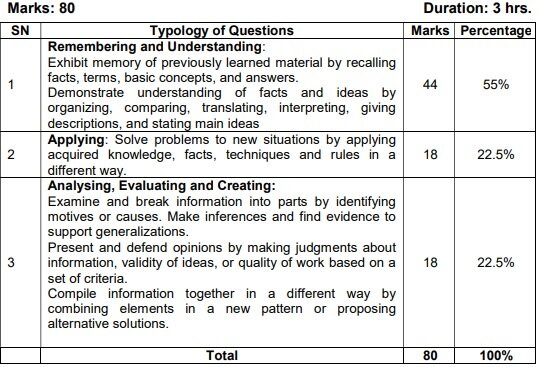Economics is a division of social science which studies the way to use scarce resources to produce valuable commodities and distribute them among different sections of society. It is among the choicest subjects for those willing to opt for Commerce or Humanities in class 12th. The most sought board of examination in India, Central Board of Secondary Education (CBSE) provides a very comprehensive economics class 11 syllabus. In this blog, we will understand the CBSE Class 11 economics syllabus in a detailed manner. You will also get to download the Economics class 11 sample paper.
This Blog Includes:
- Class 11 Economics Syllabus 2025-26
- Chapters in Class 11 Economics Syllabus
- Key Topics Covered in the CBSE Class 11 Economics Syllabus
- Typology of Questions in Class 11 Economics Board Exam: Marks Distribution
- CBSE Class 11 Economics Deleted Syllabus for 2025-26
- New Updations of the Economics Class 11 Syllabus 2025-26:
- Benefits of Viewing the Economics Class 11 Syllabus
- Economics Class 11 Sample Paper
- 7 Study Tips for Economics Class 11
- FAQs
Class 11 Economics Syllabus 2025-26
Tabulated below is the class 11 Economics syllabus for the academic year 2025-26
| Units | Chapters | Marks | Periods |
| Part A – Statistics for Economics | |||
| Unit 1 | Introduction | 15 | 10 |
| Unit 2 | Collection, Organisation and Presentation of Data | 15 | 30 |
| Unit 3 | Statistical Tools and Interpretation | 25 | 50 |
| Sub‑Total | 40 | 90 | |
| Part B – Introductory Microeconomics | |||
| Unit 4 | Introduction | 4 | 10 |
| Unit 5 | Consumer’s Equilibrium and Demand | 14 | 40 |
| Unit 6 | Producer Behaviour and Supply | 14 | 35 |
| Unit 7 | Forms of Market and Price Determination under Perfect Competition with Simple Applications | 8 | 25 |
| Sub‑Total | 40 | 110 | |
| Part C – Project Work | 20 | 20 | |
| Total (Theory + Project) | 100 | 220 |
* Unit 1 and 2 of Part A together hold a weightage of 13 marks.
Also Read: NCERT Notes Class 11 Political Science Indian Constitution at Work Chapter 6: Judiciary (Free PDF)
Chapters in Class 11 Economics Syllabus
Here is the list of chapters covered in CBSE class 11 economics syllabus. The chapters are divided into part A, and Part B.
Part A: Statistics for Economics
The CBSE class 11 economics syllabus Part A emphasises the collection, organisation and interpretation of economic data. You will gain the foundational knowledge required for statistical analysis.
- Chapter 1 – Introduction
- Chapter 2 – Collection of Data
- Chapter 3 – Organisation of Data
- Chapter 4 – Presentation of Data
- Chapter 5 – Measures of Central Tendency
- Chapter 6 – Measures of Dispersion
- Chapter 7 – Correlation
- Chapter 8 – Index Numbers
- Chapter 9 – Use of Statistical Tools
Part B: Introductory Microeconomics
PART B will introduce you to the basic economic concepts. For example, the demand and supply, and the market mechanisms. This part builds your analytical thinking skills by providing information about real-life scenarios.
- Chapter 1 – Introduction
- Chapter 2 – Consumer’s Equilibrium and Demand
- Chapter 3 – Producer Behaviour and Supply
- Chapter 4 – Forms of Market and Price Determination under Perfect Competition with Simple Applications
Key Topics Covered in the CBSE Class 11 Economics Syllabus
Here is a quick overview of the key topics covered in the economics class 11 syllabus.
| Unit | Key Topics |
| Unit 1: Introduction | 1. Concept and scope of economics 2. Role and importance of statistics in economic analysis |
| Unit 2: Collection, Organisation & Presentation of Data | 1. Primary data – surveys and basic sampling 2. Secondary data – Census, NSSO 3. Frequency distributions and tables 4. Data presentation – bar charts, pie charts, histograms, frequency polygons, ogives, and time-series graphs |
| Unit 3: Statistical Tools & Interpretation | 1. Measures of central tendency – mean, median, mode 2. Measures of dispersion – range, standard deviation, coefficient of variation 3. Pearson’s correlation (for ungrouped data) 4. Index numbers (wholesale and consumer) and their role in measuring inflation |
| Unit 4: Microeconomics – Introduction | 1. Difference between microeconomics and macroeconomics 2. Economic problems: what/how/for whom to produce and the concept of opportunity cost |
| Unit 5: Consumer’s Equilibrium & Demand | 1. Utility theory – total, marginal, diminishing marginal utility, consumer equilibrium 2.. Indifference curve approach – budget lines, maps, and equilibrium 3. Demand – individual and market demand, determinants, elasticity |
| Unit 6: Producer Behaviour & Supply | 1. Production functions in the short and long run 2. Cost types – fixed, variable, marginal, average 3. Revenue concepts – total, average, marginal 4. Supply and its elasticity |
| Unit 7: Perfect Competition – Price Determination & Applications | 1. Features of perfect competition 2. Market equilibrium through supply and demand 3. Government interventions – price ceilings and floors |
| Part C: Project Work | 1. One project per year (20 marks) covering topic selection, data collection, organisation, analysis, and presentation 2. Presentation formats include PPT, exhibitions, panel discussions, skits, etc. 3. Inclusive formats to accommodate all learners |
Typology of Questions in Class 11 Economics Board Exam: Marks Distribution
The CBSE allocates about 55% of the 80 marks to basic cognitive skills. On the other hand, applying and Analysing/evaluating/creating topics together carries about 22.5% weightage each.

Also Read: Best Books for UPSC Optional Psychology
CBSE Class 11 Economics Deleted Syllabus for 2025-26
The Economics class 11 syllabus has undergone a few changes. For the academic year 2025-26, a few parts from the syllabus have been deleted. These deleted sections are provided below.:
| Part / Unit | Deleted Topics |
| Part A – Statistics for Economics | |
| Unit 2 – Collection & Presentation of Data | Sampling & Non‑sampling errors |
| Unit 3 – Statistical Tools & Interpretation | – Weighted mean- All measures of dispersion (range, quartile deviation, mean deviation, SD, coefficients)- Simple aggregative method- Spearman’s rank correlation (both repeated & non‑repeated ranks) |
| Part B – Introductory Microeconomics | |
| Unit 5 – Consumer’s Equilibrium & Demand | Total expenditure method |
| Unit 7 – Market Forms and Price under Competition | Features of monopoly, monopolistic competition, and oligopoly (their meanings & characteristics) |
New Updations of the Economics Class 11 Syllabus 2025-26:
The key update for the economics syllabus is that it includes topics such as the recent economic trends and events, and new government policies or reforms. The syllabus also talks about the use of digital tools in economics. Moreover, case studies and data analysis are given. A few adjustments have been made regarding the marks’ weightage for topics.
Benefits of Viewing the Economics Class 11 Syllabus
You must check the CBSE Class 11 Economics syllabus before sitting for the exam. There are many reasons for it. Some of these reasons are:
- Going through the syllabus will help you understand the key topics to be studied. You will be able to understand the high-scoring topics.
- You will get to learn how marks are distributed
- You will understand the guidelines for project work and about viva.
- Checking the syllabus often gives a quick grasp of the topics to be covered. It saves time.
Economics Class 11 Sample Paper
To help you score better in your upcoming examinations, here are some of the sample papers for class 11 Economics-
7 Study Tips for Economics Class 11
Economics Class 11 plays an essential role in building the foundation of major economic theories and concepts that are further studied at an advanced level in Class 12 Economics. To help you prepare for the economics exam, here are the major study tips and strategies you can utilise to get a higher score:
- Master all the major concepts of Indian Economic Development and Statistics through NCERT Books as they can be your essential guide in understanding every topic in a simple manner as well as practising important questions.
- There are many reference Economics books you must have while exploring different concepts and some of the popular ones for Class 11 & 12 are by T.R. Jain, T.S. Grewal, V K Ohri and CB Sachdeva.
- Don’t cram up definitions but understand them thoroughly and explain in your own language.
- Make sure to create tables to explain the difference between any two concepts asked in the exam.
- For formulas and economics theories, use graphic presentations like tables, charts, graphs, etc. as they can help you achieve better scores.
- For numericals, practice as many questions as possible before the exam as this will help you remember the formulas better and understand the type of questions that might come in the exam.
FAQs
Class 11 Economics is not everyone’s cup of tea. But with constant practice and revision, you can ace the subject.
The chapters covered under Class 11 Economics are-
Part A: Statistics for Economics
Chapter 1 – Indian Economy on the Eve of Independence
Chapter 2 – Indian Economy (1950 – 1990)
Chapter 3 – Liberalisation, Privatisation and Globalisation: An Appraisal
Chapter 4 – Poverty
Chapter 5 – Human Capital Formation In India
Chapter 6 – Rural Development
Chapter 7 – Employment Growth, Informalisation and Other Issues
Chapter 8 – Infrastructure
Chapter 9 – Environment And Sustainable Development
Chapter 10 – Comparative development Experiences Of India and Its Neighbors
Part B: Introductory Microeconomics
Chapter 1 – Introduction
Chapter 2 – Collection of Data
Chapter 3 – Organisation of Data
Chapter 4 – Presentation of Data
Chapter 5 – Measures of Central Tendency
Chapter 6 – Measures of Dispersion
Chapter 7 – Correlation
Chapter 8 – Index Numbers
Chapter 9 – Use of Statistical Tools
Adam Smith is known as the father of Economics.
In order to learn how one can achieve social welfare and get maximum satisfaction with limited resources, it is important for one to study the course of Economics.
Related Articles:
This was all about Economics class 11 chapters and important topics. If you are planning to make a career in Economics 410, but are not sure about the ways to do it, seek help from Leverage Edu’s AI-based tool and explore a wide range of programs and universities to find a suitable combination that fits your interests. Book your free career counselling session 410 with us to make a great career ahead!

 One app for all your study abroad needs
One app for all your study abroad needs





















 60,000+ students trusted us with their dreams. Take the first step today!
60,000+ students trusted us with their dreams. Take the first step today!

